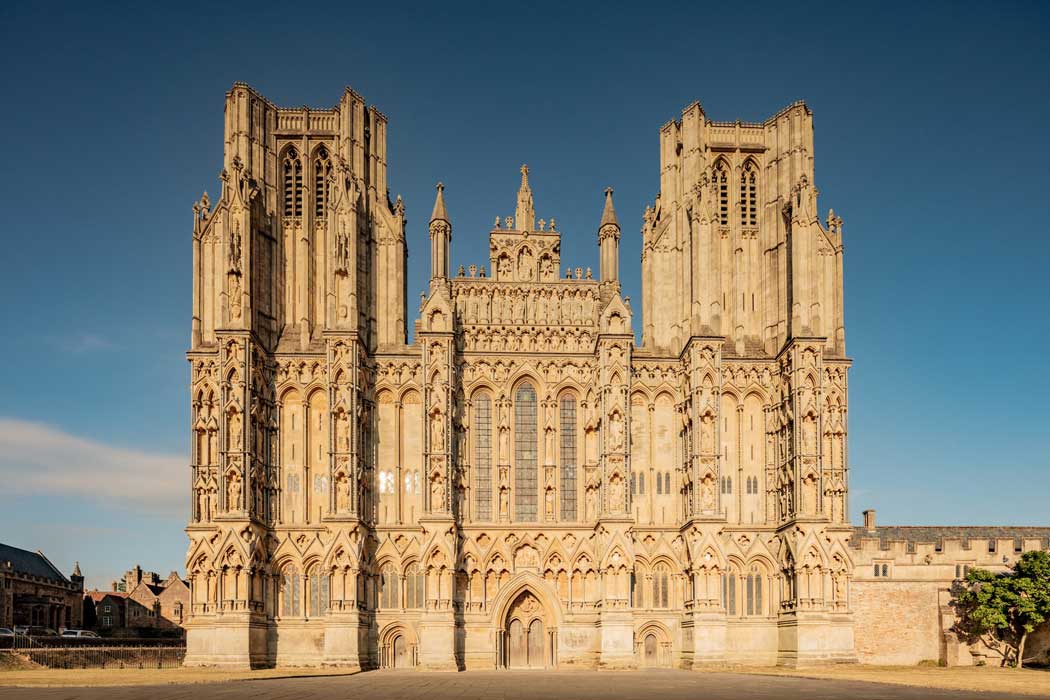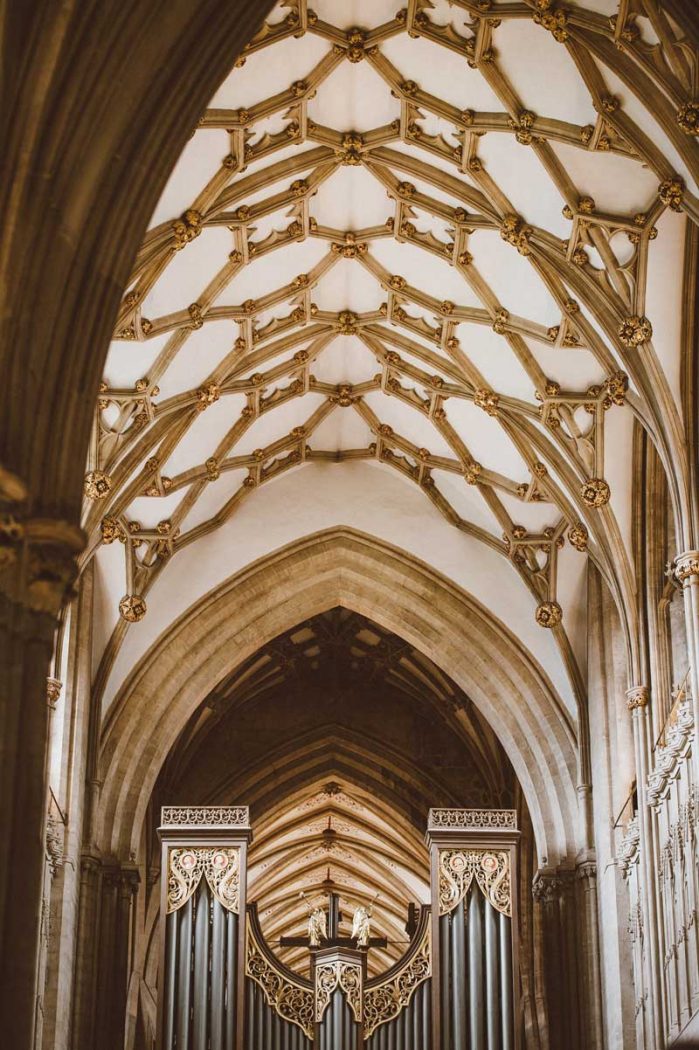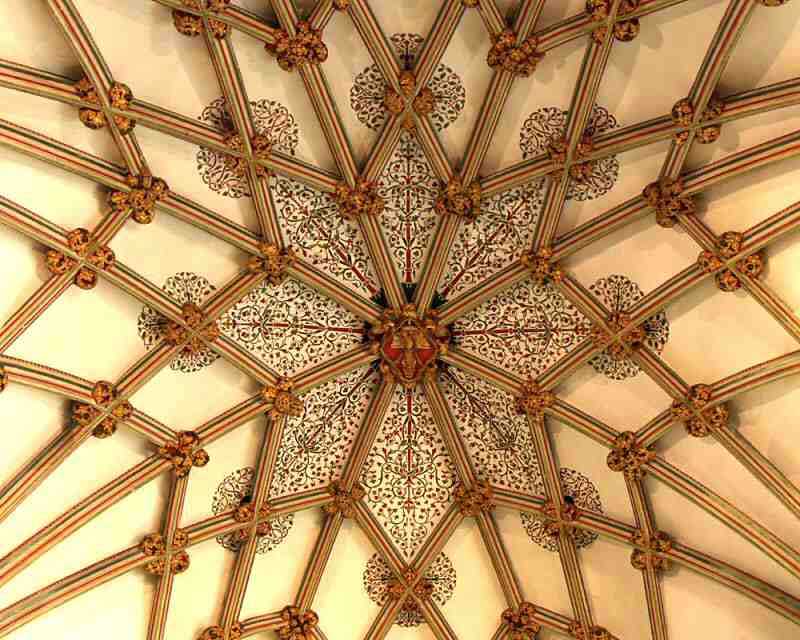Wells Cathedral was built between 1175 and 1490, although an abbey church has been on the site since as early as 705. The cathedral has been the seat of the Bishop of Bath and Wells since the 13th century and for this reason, Wells has played a much greater role in history than most other places of a similar size.
The cathedral is also the main reason why Wells is considered a city and not a town. The reason for this is that in the United Kingdom, city status is granted by the monarch who, in most instances, will not consider a place important enough to be a city unless it has its own cathedral.
It is a stunning piece of architecture and one of the main reasons that people visit Wells.
What to see at Wells Cathedral
The cathedral is a Grade I listed building that is one of the most beautiful examples of early English Gothic architecture. It is an impressive building, particularly for such a small city.
Although it has some other architectural styles, Wells Cathedral features a more harmonious appearance with a much larger portion of the building constructed in a single architectural style than you would see in many other English cathedrals and this is particularly noticeable when looking at the cathedral’s exterior.
The cathedral’s ornate west front measures 30m (100 ft) high and 45m (147 ft) wide. It has twin towers that are unique in the sense that they do not indicate the location of the aisles. While the west front’s lowest level is relatively plain, the upper levels are considerably more intricately decorated with quatrefoils and niches that hold around 300 statues (it would have originally held closer to 400 at the time of construction).
Although the two towers of the cathedral’s west front do not have spires like many other cathedrals, it is still considered to be the highest development in English Gothic architecture of this type of facade. The southwest tower is home to the world’s heaviest ring of 10 bells.

Other points of interest in the cathedral’s exterior include the 13th-century central tower, which was substantially rebuilt in the 14th century, and the north porch. Although much plainer than the west front, the cathedral’s north porch was designed as the main entrance.
The cloisters, which date from the late 13th century, feature vaulted ceilings. It is considered unusual for Wells Cathedral to have cloisters considering that it was not built as a monastic cathedral.
A library is located above the eastern cloister, which houses a collection of rare books that includes a set of Aristotle’s works that once belonged to Erasmus as well as Pliny’s Natural History from 1472 and a 1606 world atlas by Abraham Ortelius. The library is normally closed to visitors but there is a small exhibition space that is open to the public at specific times during the summer and guided tours operate every couple of weeks that allow you to visit this area.
The interior of the cathedral is equally impressive as its exterior. Highlights include the vaulted ceilings in the quire, transept and nave as well as the St Andrew’s Cross arches, also known as the scissor arches, that act as a decorative supporting structure to the cathedral’s central tower.

![The central tower is supported by the St Andrew's Cross arches, also known as the scissor arches. (Photo: Jörg Bittner Unna [CC BY-SA 3.0])](https://englandrover.com/wp-content/uploads/2018/09/wells-cathedral-st-andrews-cross-scaled.jpg)

The chapter house was built in the 13th and 14th centuries and features a ribbed vaulted ceiling supported by a central column.
In addition to its architectural significance, Wells Cathedral is noted for its attention to detail including its stained glass windows and its intricate carvings.
Despite suffering damage from Parliamentary forces in 1642–1743 during the English Civil War, Wells Cathedral boasts one of England’s most complete collections of medieval stained glass and its oldest stained glass dates from the 13th century.
The cathedral’s interior features a multitude of stone carvings including the chantry in the nave as well as ornate capitals on the structure’s supporting columns; however, the highlight is its collection of misericords, which is considered to be among the finest in the country.
The Wells Cathedral clock in the north transept is believed to date from around 1325. The mechanism was replaced in the 19th century with the original mechanism on display at the Science Museum in London. The clock features two faces, which include a 24-hour clock face that depicts the sun and moon revolving around the Earth on the interior of the cathedral and a 12-hour clock face on the cathedral’s exterior. It is England’s second-oldest clock after the one at Salisbury Cathedral.
Visiting Wells Cathedral
Wells Cathedral is located at the northeastern end of the city centre immediately north of the Bishop’s Palace and Gardens.
With over 1,000 services held here every year, Wells Cathedral is a working cathedral as much as it is a tourist attraction and it is one of the few major cathedrals in England to not charge tourists an admission fee, although donations are appreciated. An annual pass is available for £15 which allows you fast-track access to the cathedral for 12 months.
Most people visit the cathedral independently, simply turning up and wandering around. However, there is also a programme of guided tours for those who enjoy having an expert point out both the history behind the cathedral and its architectural highlights.
Guided tours include the Outside Tour, which focuses on the building’s exterior and the precinct surrounding it; the High Parts Tour, which takes you behind the scenes to the singing gallery, the roof space and to the chamber behind the cathedral clock and the Chained Library Tour, which lets you visit the library. Note: the High Parts Tour does not take you to the top of the tower.
Tours depart from the donation desk at the New Entry Cloister and you should book your tickets online in advance.
If you are visiting the cathedral independently, then you may pick up a leaflet that points out the main points of interest. Visitor leaflets are available in 11 languages and Braille and large print leaflets are available.
Most parts of the cathedral are wheelchair accessible; however, wheelchair access was not a consideration when it was built around 800 years ago and some areas such as the chapter house, the library and the High Parts Tour are not wheelchair accessible.
The cathedral also takes part in local events and is regularly used as a venue for concerts and theatrical performances.
The cathedral has a gift shop and a cafe, which is a nice place to enjoy a cream tea. The cathedral’s location in the city centre means that there are plenty of other places to eat and drink nearby.
Allow 1–2 hours for your visit as there is quite a lot to see here.


There are no comments yet.